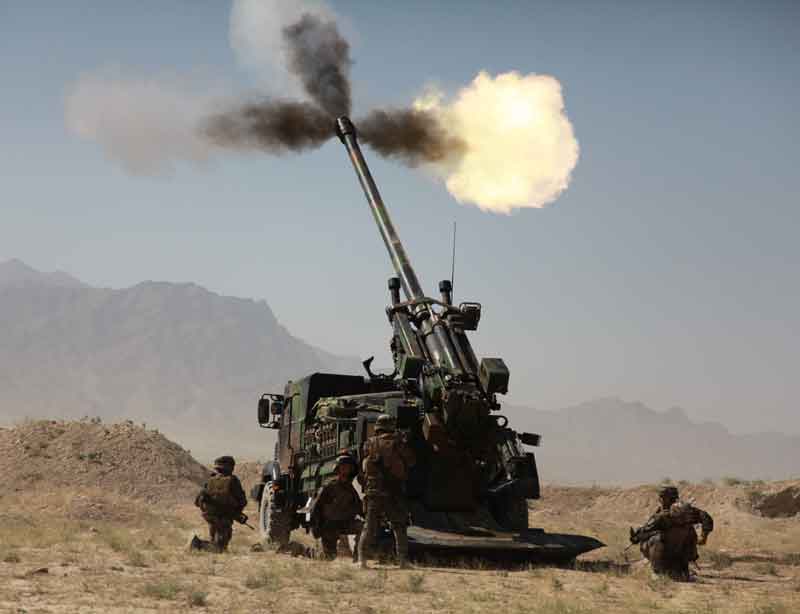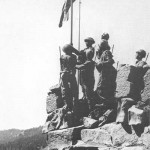Many experts and talented observers predicted that towed guns would be completely replaced in coming decades by automotive-mounted arms, with truck-mounted pieces and howitzers seen as the preferred solutions. Nevertheless, there is still room for towed guns as some recent and ongoing programs have shown.
The lightness of towed guns remains a crucial element to consider for the rapid deployment or shipment by air of early entry forces from several formations: Special Forces, airborne, mountain infantry or marines corps. In regular mechanised forces, towed guns are still relevant in static combat situations, such as in some borders areas between India and Pakistan, for example. During the Kargil War, the Indian towed FH70, manufactured by Bofors, dominated their Pakistani counterparts which were not able to return efficient fire. Bofors were once very popular in the Indian market. The Swedish company invested millions in the design of its brand new FH77 155-52, and carried out no less than five live test campaigns in India under “no cost, no commitment” conditions. When the new tender was issued last year, it appears that the technical specifications were very different from the Swedish design, leaving Nexter and Soltam free to bid.
During the Kargil War, the Indian towed FH70, manufactured by Bofors, dominated their Pakistani counterparts which were not able to return efficient fire.
Nexter Systems is engaged in one of the biggest artillery programs ever. The Indian army intends to purchase hundreds of towed155 mmguns to replace old Russian designed assets, and to supplement the Bofors FH70 acquired in the ‘80s. Around 1350 pieces are to be manufactured under licence in India with the assistance of a foreign technology supplier. India is looking for a large spectrum of artillery assets to cover a wide range of missions. Beside the towed version, the Indian army has also launched four additional programs, all featuring the155 mmcalibre. These include truck mounted guns, armoured wheeled howitzers, armoured tracked howitzers and an ultra light gun able to be moved by a helicopter, for a total of more than 2200 pieces!
To design its new Trajan towed gun, Nexter Systems relied heavily on the combat proven, truck-mounted Caesar, which is performing superbly in Afghanistan from the FOB held by the French army. The Trajan uses the Caesar oscillating ensemble, namely the ordnance itself, the recoiling system, the shell semi-automatic loading mechanism, the azimuth and elevation drive system. The Trajan ordnance is 100% identical to the original Caesar design, with the highly reliable screw breech automatic locking and the two stage muzzle break. The INS is directly attached to the cradle in order to get the absolute positioning of the gun. The Caesar INS is a Sagem Sygma 30. Nexter has not confirmed yet whether the Sagem equipment will be selected for the Indian program, although Sagem is very active in India.
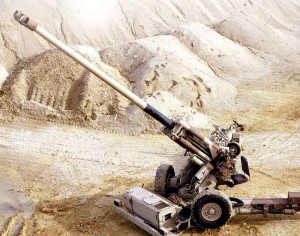
Trajan combines two main sub-systems the Caesar 155-52 ordnance and the modified carriage of the 155
Larsen & Tubro will be the main industrial operator in India to manufacture the Trajan. The lower part of the Trajan will be designed by L&T under the supervision of Nexter, who will retain authority over the design of Trajan. This carriage will be inspired by the in house TRF1 155/39 calibre gun. This towed gun was successfully used during the first Gulf war in 1991 as the main artillery asset of the French motorised Dagaie division. The artillery system has also been exported to Saudi Arabia with the SA National Guard, and to Cyprus. The carriage will provide the gun with hydraulic energy for the azimuth and elevation driving and for the shell loading mechanism. A diesel engine embedded in a front box will drive a pump and a transmission. The Trajan will have a self mobility capability, able to move the gun for short distances. This has two main purposes: to set the gun in battery when it is released from its mother truck, and to change the firing position without hocking again.
Thanks to new high elasticity steel which reduces the weight of the carriage frame, the Trajan will move on a single axle, while many competitors have two. To fulfil a specific Indian requirement, the Trajan will be equipped with a small manipulating arm to carry shells from pallets or trucks to the firing position. This kind of equipment was already used on the Indian FH70.
India is looking for a large spectrum of artillery assets to cover a wide range of missions. Beside the towed version, the Indian army has also launched four additional programs, all featuring the 155 mm calibre.
Two prototypes are currently under production. The first one will perform an intensive qualification program in France. This will be quickly followed by a second, which will be manufactured in L&T facilities in India where it will be used for complementary trials under various climatic conditions.
Nexter might also offer its new Bacara battery fire control system. It is expected that the Trajan will be fully digitised with a derivative of the in-house Top & Ready ballistic computer which is aboard Caesar. The Indian artillery corps is still using rather old fire control systems inherited from the Soviet era. The artillery modernisation program requires quicker response times and MRSI capabilities, as well as, brand new guns. The performance of the French Caser has evolved during operations in Afghanistan, particularly target location and ballistic computation, to the point where it can open fire less than three minutes after target detection. It is very fast.
The French company has another interesting towed gun in its portfolio: the 105LG. This small artillery asset has been sold to six countries – Singapore, Thailand, Canada, Belgium, Colombia, and Indonesia. Saudi Arabia is looking for a similar system, and Turkey is developing its own system. The Turkish army is requesting a light support gun able to be moved under sling with a Sikorsky UH-60 Blackhawk helicopter. The role of this new artillery system will be to provide fire support to specialised infantry in the mountainous areas of Kurdistan and East Turkey. MKE, the Turkish state owned industrialist, is developing an indigenous design to meet the national requirement – with the help of 105 mm ammunitions supplied by Nexter Munitions.
The main European contender is the BAE Mk 119. It is in service in many armies, the biggest user being the US Army. Nevertheless, the success story of the British manufacturer is the M777. More than a thousand pieces have been ordered so far by the US Army, the Marines Corps, the Canadian army and the Australian army. India and USA are negotiating the purchase of 145 pieces under the FMS procedure. The M777 is extensively used in Afghanistan where it is generally moved under sling of a CH47. Despite heavy manpower and a low rate of fire, the M777 has proved to be a useful asset to provide fire support in complex areas such as mountains. Its efficiency is dramatically improved with the use of Excalibur GPS guided round.
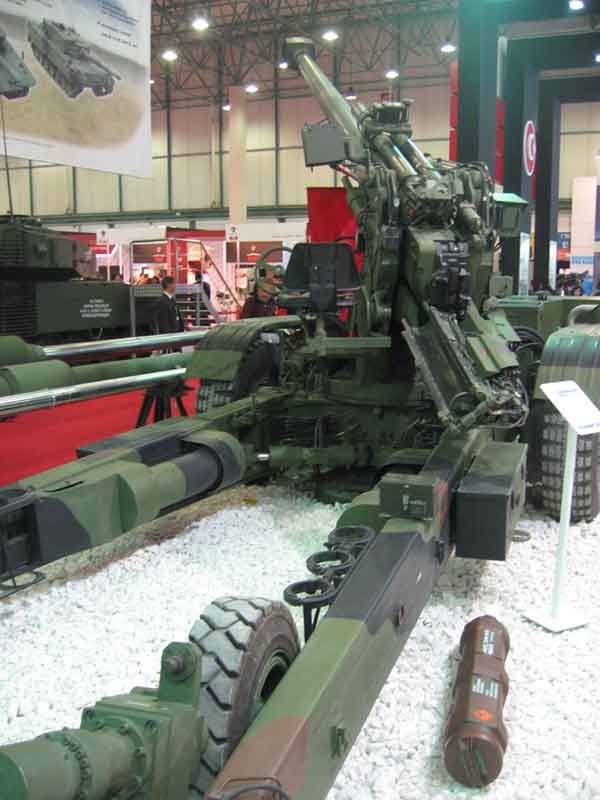
Panter is the Turkish adaptation of the Singapore STK FH2000. it is manufactured under licence by MKE. (photo MC)
Designers have adopted smart materials such as titanium to meet ambitious new goals in terms of air transport capabilities. This light but resilient metal is heavily used in the frame of the gun. All subsystems are manually operated or slightly assisted with a hand pump. For weight reasons, the M777 cannot be fitted with an independent engine that could have provided assistance to the crew. This means that operationally, the battery takes rather a long time to charge before firing the first round.
The Indian artillery corps is still using rather old fire control systems inherited from the Soviet era. The artillery modernisation program requires quicker response times and MRSI capabilities, as well as, brand new guns.
In Spain, General Dynamics European Land Systems- Santa Barbara is promoting its SB 155-52 calibre towed gun. This product is in service in Spain and has been ordered by Colombia for the equipment of a full battalion. The SB 155-52 features an automatic breech block locking system, a hydraulic flick rammer and a 10 igniters revolving box. The SB 155-52 is credited with a high rate of fire, close to ten rounds a minute. It is fully compliant with the JBMOU standard. A crew of seven is required to serve the gun. The SB 155-52 has a self mobility capability provided by a 78 kW diesel engine. Its twin axle allows the gun to move at speeds of up to 18 km/h on tracks and roads. The diesel engine drives a hydraulic pump which provides power to rim mounted hydraulic motors.
An INS attached to a ballistic computer makes the SB 155-52 afully autonomous gun. In addition, muzzle velocity radar can be attached on the cradle as an option.
The gun is rather heavy – almost 14 tonnes – and can only be towed by powerful trucks that also carry crew and ammunitions. In January, the Spanish army shipped some SB 155-52 to the disputed Melilla enclave on the Moroccan coast. These guns equip the Regimiento Mixto de Artilleria 32.
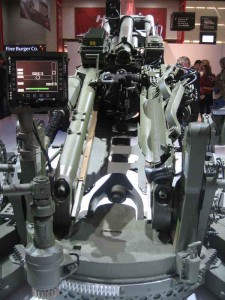 With the acquisition of the South African company Denel, Rheinmetall added two more artillery system to its portfolio: the towed G5 and the G6 wheeled howitzer. When Denel was blacklisted in India, it tried to do business under the Rheinmetall banner. To do so, Rheinmetall integrated its 155-52 ordnance into the G6. This gun was taken from the PZH 2000 heavy tracked howitzer. A similar same recipe was used with the G5, which was previously fitted with a 45 calibres barrel from a South African original design. The new gun might be a contender in the Indian competition.
With the acquisition of the South African company Denel, Rheinmetall added two more artillery system to its portfolio: the towed G5 and the G6 wheeled howitzer. When Denel was blacklisted in India, it tried to do business under the Rheinmetall banner. To do so, Rheinmetall integrated its 155-52 ordnance into the G6. This gun was taken from the PZH 2000 heavy tracked howitzer. A similar same recipe was used with the G5, which was previously fitted with a 45 calibres barrel from a South African original design. The new gun might be a contender in the Indian competition.
The Turkish army has started a large modernisation program aimed at replacing aging ‘60s assets with new pieces of modern equipment. The artillery corps has already received dozens of Firtina 155-52 tracked howitzers, a system produced under a South Korean licence granted by Samsung. The Firtina is supplemented by the towed MKE 155-52 Panther gun, also produced under the licence of STK in Singapore. The MKE 155-52 gun is in fact the FH 2000. MKE is the prime contractor of the Panther. The Panther features a diesel engine which gives autonomous mobility and assistance to the crew during the crucial phase of setting in and out of battery. As with all 52 calibre guns, the Panther can reach a range of 40 km with dedicated rounds that can withstand the pressure and the acceleration generated by the charge 6 of the JBMOU. The Turkish army is currently firing South Korean shells from Doosan. MKE is developing an indigenous family of 155 rounds and the associated propelling charges. The Turkish company is also seeking to provide those rounds with some kind of insensitive explosive to reduce hazards on the battlefield, and especially in the supply chain. The first proof of principle rounds were fired last year, and full scale development and qualification trials are expected to be completed within two years. Denel is also involved in the Turkish ammunition program by supplying the base bleed technology crucial for the full range.
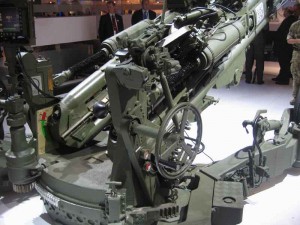 Patria is another major European player in the field of towed artillery systems. The Finnish manufacturer has supplied hundreds of pieces to the Finnish Defence Forces. The Finnish artillery corps is still one the biggest in Europe, if not the biggest. The Finnish strategic position has always been to put the artillery in front of the potential threat, namely Russia. The Patria 155 GH 52 APU features a classical design able to cope with the severe local climatic conditions. Its 52 calibre barrel is able to propel a regular 155 round up to40 kilometres. The APU is based on a Deutz diesel engine of 78 kW. Fifty six pieces of 155 GH 52 APU, known in the Finnish army as 155 K98, have been manufactured for the national market. They equip the Kainuu artillery regiment and the artillery brigade in Niinisalo.
Patria is another major European player in the field of towed artillery systems. The Finnish manufacturer has supplied hundreds of pieces to the Finnish Defence Forces. The Finnish artillery corps is still one the biggest in Europe, if not the biggest. The Finnish strategic position has always been to put the artillery in front of the potential threat, namely Russia. The Patria 155 GH 52 APU features a classical design able to cope with the severe local climatic conditions. Its 52 calibre barrel is able to propel a regular 155 round up to40 kilometres. The APU is based on a Deutz diesel engine of 78 kW. Fifty six pieces of 155 GH 52 APU, known in the Finnish army as 155 K98, have been manufactured for the national market. They equip the Kainuu artillery regiment and the artillery brigade in Niinisalo.
In early 2000, Patria signed a licence agreement with Egypt. The TDP of the oscillating part of the 155 GH 52 APU was sold to Military Production, a branch of the Egyptian Ministry of Defence. The project consisted in designing a self propelled gun based on a T55 chassis and the Finnish gun. The concept was close to the old French F3 based on AMX13.
With a rear located power pack, the T55 was not suitable for such a design. Furthermore, the Finnish TDP proved to be irrelevant for the application and the project failed.




